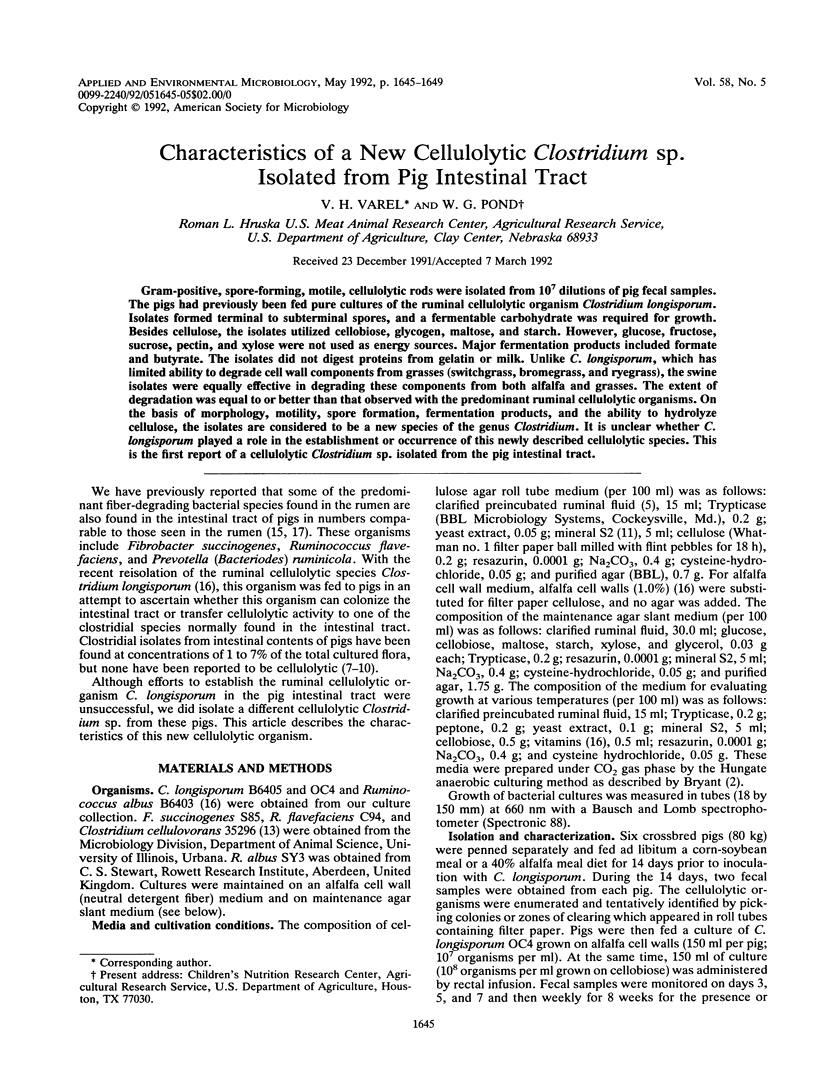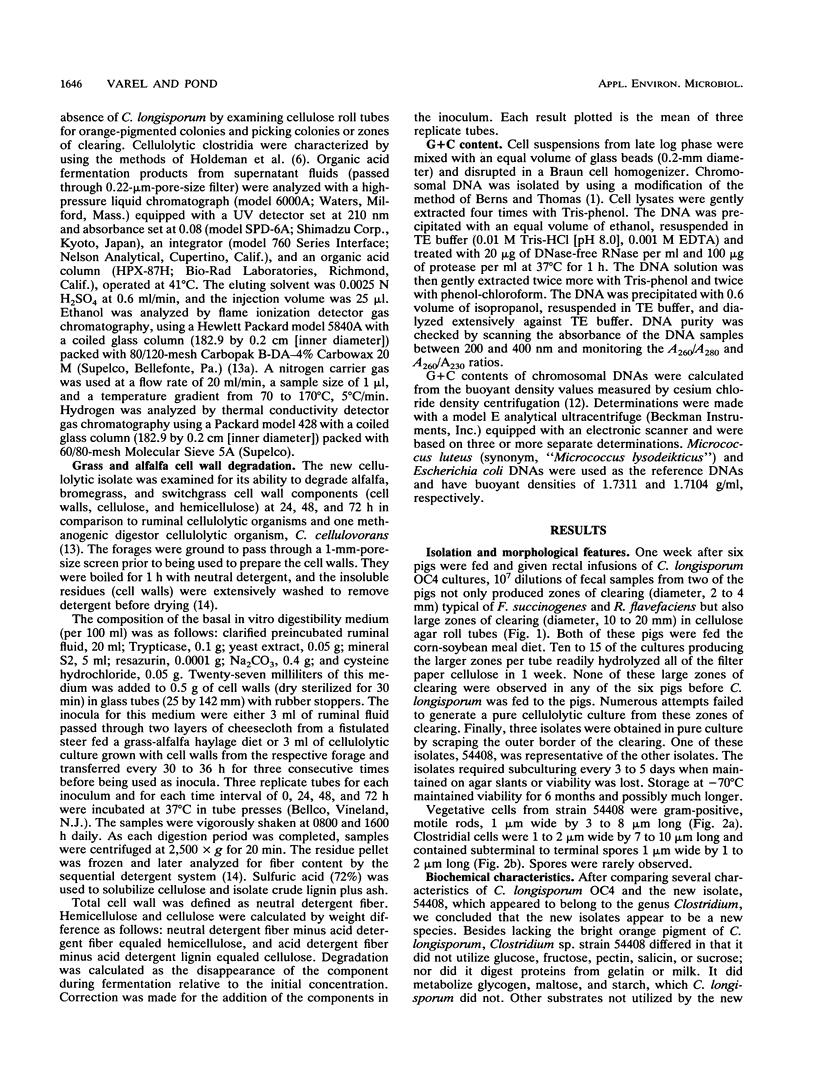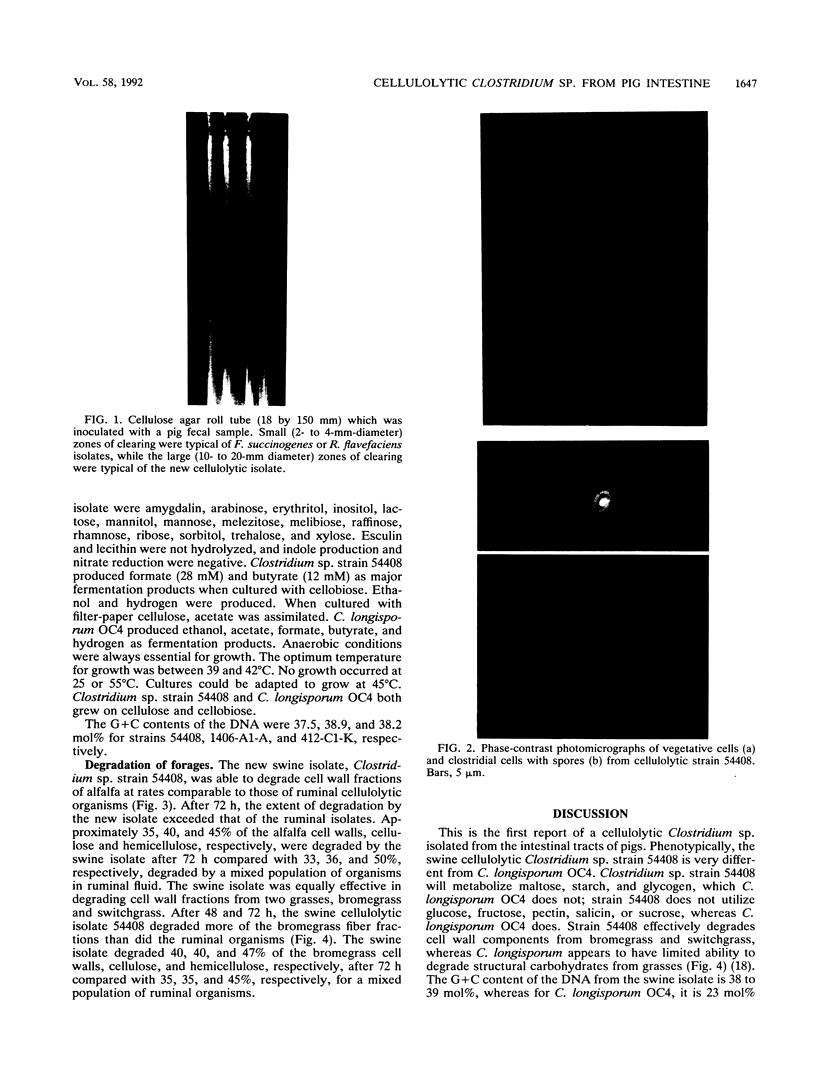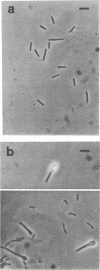Abstract
Gram-positive, spore-forming, motile, cellulolytic rods were isolated from 10(7) dilutions of pig fecal samples. The pigs had previously been fed pure cultures of the ruminal cellulolytic organism Clostridium longisporum. Isolates formed terminal to subterminal spores, and a fermentable carbohydrate was required for growth. Besides cellulose, the isolates utilized cellobiose, glycogen, maltose, and starch. However, glucose, fructose, sucrose, pectin, and xylose were not used as energy sources. Major fermentation products included formate and butyrate. The isolates did not digest proteins from gelatin or milk. Unlike C. longisporum, which has limited ability to degrade cell wall components from grasses (switchgrass, bromegrass, and ryegrass), the swine isolates were equally effective in degrading these components from both alfalfa and grasses. The extent of degradation was equal to or better than that observed with the predominant ruminal cellulolytic organisms. On the basis of morphology, motility, spore formation, fermentation products, and the ability to hydrolyze cellulose, the isolates are considered to be a new species of the genus Clostridium. It is unclear whether C. longisporum played a role in the establishment or occurrence of this newly described cellulolytic species. This is the first report of a cellulolytic Clostridium sp. isolated from the pig intestinal tract.
Full text
PDF




Images in this article
Selected References
These references are in PubMed. This may not be the complete list of references from this article.
- Dehority B. A., Grubb J. A. Basal medium for the selective enumeration of rumen bacteria utilizing specific energy sources. Appl Environ Microbiol. 1976 Nov;32(5):703–710. doi: 10.1128/aem.32.5.703-710.1976. [DOI] [PMC free article] [PubMed] [Google Scholar]
- Moore W. E., Moore L. V., Cato E. P., Wilkins T. D., Kornegay E. T. Effect of high-fiber and high-oil diets on the fecal flora of swine. Appl Environ Microbiol. 1987 Jul;53(7):1638–1644. doi: 10.1128/aem.53.7.1638-1644.1987. [DOI] [PMC free article] [PubMed] [Google Scholar]
- Robinson I. M., Whipp S. C., Bucklin J. A., Allison M. J. Characterization of predominant bacteria from the colons of normal and dysenteric pigs. Appl Environ Microbiol. 1984 Nov;48(5):964–969. doi: 10.1128/aem.48.5.964-969.1984. [DOI] [PMC free article] [PubMed] [Google Scholar]
- Russell E. G. Types and distribution of anaerobic bacteria in the large intestine of pigs. Appl Environ Microbiol. 1979 Feb;37(2):187–193. doi: 10.1128/aem.37.2.187-193.1979. [DOI] [PMC free article] [PubMed] [Google Scholar]
- SCHILDKRAUT C. L., MARMUR J., DOTY P. Determination of the base composition of deoxyribonucleic acid from its buoyant density in CsCl. J Mol Biol. 1962 Jun;4:430–443. doi: 10.1016/s0022-2836(62)80100-4. [DOI] [PubMed] [Google Scholar]
- Salanitro J. P., Blake I. G., Muirhead P. A. Isolation and identification of fecal bacteria from adult swine. Appl Environ Microbiol. 1977 Jan;33(1):79–84. doi: 10.1128/aem.33.1.79-84.1977. [DOI] [PMC free article] [PubMed] [Google Scholar]
- Salanitro J. P., Fairchilds I. G., Zgornicki Y. D. Isolation, culture characteristics, and identification of anaerobic bacteria from the chicken cecum. Appl Microbiol. 1974 Apr;27(4):678–687. doi: 10.1128/am.27.4.678-687.1974. [DOI] [PMC free article] [PubMed] [Google Scholar]
- Sleat R., Mah R. A., Robinson R. Isolation and Characterization of an Anaerobic, Cellulolytic Bacterium, Clostridium cellulovorans sp. nov. Appl Environ Microbiol. 1984 Jul;48(1):88–93. doi: 10.1128/aem.48.1.88-93.1984. [DOI] [PMC free article] [PubMed] [Google Scholar]
- Varel V. H. Activity of fiber-degrading microorganisms in the pig large intestine. J Anim Sci. 1987 Aug;65(2):488–496. doi: 10.2527/jas1987.652488x. [DOI] [PubMed] [Google Scholar]
- Varel V. H., Fryda S. J., Robinson I. M. Cellulolytic bacteria from pig large intestine. Appl Environ Microbiol. 1984 Jan;47(1):219–221. doi: 10.1128/aem.47.1.219-221.1984. [DOI] [PMC free article] [PubMed] [Google Scholar]
- Varel V. H. Reisolation and characterization of Clostridium longisporum, a ruminal sporeforming cellulolytic anaerobe. Arch Microbiol. 1989;152(3):209–214. doi: 10.1007/BF00409652. [DOI] [PubMed] [Google Scholar]
- Varel V. H., Richardson A. J., Stewart C. S. Degradation of barley straw, ryegrass, and alfalfa cell walls by Clostridium longisporum and Ruminococcus albus. Appl Environ Microbiol. 1989 Dec;55(12):3080–3084. doi: 10.1128/aem.55.12.3080-3084.1989. [DOI] [PMC free article] [PubMed] [Google Scholar]




